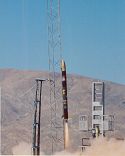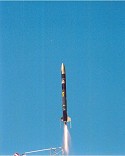|
December
12, 2003
Aerospike
& other studies are on the agenda according to Dr.
Eric Besnard, professor at the CSULB
Mechanical and Aerospace Engineering Department, and John Garvey,
head of Garvey Spacecraft.
They led the student/industry team that just launched their second
rocket with an aerospike
nozzle on a liquid fueled engine. They were the first
to succeed at flying such a system. See their launch
news page, which has a new photo of the rocket returning via
parachute.
The team has
a number of possible avenues of research to follow, assuming they
can obtain funding. According to John:
Related to
aerospike performance studies, altitude compensation
measurements are only one component of the research space. Eric
can give
you the specifics, but here are some other areas of interest,
in large part
for refining CFD models:
- Plume
interaction with the boundary layer at near-transonic conditions
(note - this is actually at low altitudes and velocities, which
we can
achieve with the current vehicles if we have an engine with
appropriate
burn characteristics)
- Plume interaction
with the boundary layer under asymmetric
engine/vehicle orientations (i.e. - different angles of attack
and/or
during engine gimbaling if that is how thrust vector control
is
implemented)
- Plume configurations
for a variety of thrust vector control techniques
and flight conditions
To fully
address these, we need to achieve the expansion ratios of a high-performance
engine - on the order of say fifty-to-one. However, the present
aerospike engine is designed for an expansion ratio of around
five, primarily because of the limitations of the engine materials
that we can afford and the scale of the vehicle/engine. The width
of the exit orifice is on the order of millimeters - it would
have to be reduced by a factor of ten to get the high expansion
ratios with this size engine [...]. This might be doable, but
EDM graphite (the material from which the exit ring and spike
are made of for cost reasons) erodes quickly, so the expansion
ratio decreases as the gap widens during a burn. Thus, we could
do more to increase the general performance of the [Prospector
4 rocket] (add a regulated GHe pressurization system, increase
chamber pressure, throw on more instrumentation, even add TVC,
conduct a series of static fire test to really characterize engine
burn parameters, etc.), but can only go so far with respect to
data quality/validity until we improve the engine more.
One option we have tried to pursue is replacing the graphite elements
with high-temperature materials that experience much lower erosion
rates and potentially much tighter dimensional tolerances and
stability. However, not surprisingly, these materials are expensive
- based on the initial costs estimates we have been getting, our
team can build an entire new vehicle for the price of a single
set of such components at standard prices. Our proposals to get
external funding to procure such components have not been picked
up (in general, we are a lot more successful at flying vehicles
than winning contracts and aerospikes are not of as much interest
to the core aerospace community as they were five years ago when
X-33 was underway), so our other option here is to find a materials
outfit that is interested/willing to work with us at discounted
rates.
Alternatively,
Eric has some ideas about next-generation aerospike engines that
would be more effective in dealing with these constraints than
the present design (which we have always considered to be an early
interim configuration) and would have more fidelity with the operational
configurations that NASA, Rocketdyne, et. al. have developed over
the years. These too are dependent on advanced materials, but
we believe we can get started on developing the key elements with
our existing capabilities and contacts. However, such an approach
probably means it would be a while again before we put an aerospike
vehicle back into the air.
The
SDSU/Flometrics team didn't get a chance for a launch
last weekend but they did get a good dress rehersal for their next
chance as shown by the pictures at the SDSU
Rocket Launch page.
December
10, 2003
Aerospike
launch update... The Cal State Long Beach site now has
a report with photos on the launch: Successful
Second Liquid-propellant Aerospike Engine Flight Onboard P-4 - CSULB
- Dec.10.03.
December
8, 2003
CSULB/Garvey
aerospike launch success... The second flight of a liquid
fueled engine with an aerospike nozzle was a success! The Prospector
4 rocket built by Cal
State Long Beach and Garvey
Spacecraft took off from the Mojave test site of the Reaction
Research Society (RRS) over the weekend and returned safely
to the ground.
The problem
with the engine in the first
aerospike flight in September did not occur this time.
"Overall
it was a very good flight. The engine worked flawlessly this time."
See photos
and videos of the launch and parachute return.
Thanks to Steve
Harrington for this item.
SDSU/Flometrics
launch postponed... This message from Steve Harrington
of Flometrics
about the rocket built with the AIAA
chapter at San Diego State University:
The good news
is that we got the rocket back in perfect condition, the bad news
is that Edwards Air Force Base was using the airspace and the
wind was picking up, so we were not able to get a launch window.
We will try again soon. Also, since the rocket is finished, we
will start work on the pump rocket which will use two of our pumps
to acheive a mass ratio of 4 or so without expensive components
or processes. This will give us the capability to launch to 100
miles, if we can get the paperwork figured out and we can find
some more sponsors.
December
5, 2003
Unity
update... The website
has been moved and updated for the Brigham Young / Utah State Unity
IV hybrid rocket project. The site offers videos
and pictures of the 20 foot vehicle to 4400 feet and its recent
launch on December 2.
December
3, 2003
Utah
hybrid launch... A Brigham Young/Utah State student team
on Dec 2 launched a 20 foot hybrid rocket to 4400 feet from the
Dugway Proving Grounds in western Utah. BYU team member Brady Woolford
says the Unity IV project should soon have video and pictures on
their website.
(Got the news originally via ia Jonathan Goff)
December
2, 2003
Weekend
launches... Steve Harrington of Flometrics
sent out this announcement today:
We will be
launching a LOX/Kerosene 1000 lb thrust rocket on Sunday Dec 7th
at the reaction research society MTA (www.rrs.org)
The San Diego
State/Flometrics team learned about hard starts in September.
(See www.sdsurocket.org
) The rocket has been repaired and improved and we are going to
launch on Sunday. The Garvey Spacecraft/Cal State Long Beach Team
[see item below] will be launching an upgraded version of their
aerospike rocket as well. There will be other launces and tests
as well.
The SDSU rocket
project is intended to give the students a good hands on introduction
to liquid fueled rockets. I will be teaching rocket
propulsion next semester and the class project will be to
design, build and static fire a LOX/Kero rocket which uses our
low cost fuel pump (www.rocketfuelpump.com)
The pump allows for a low cost rocket booster that can achieve
a high mass ratio without low safety margins, perfect welding,
exotic materials etc that drive up the costs of typical boosters.
If you would
like to come out to the launch (near Mojave, about 2 hrs from
LA ) let me know and I will send instructions.
News
brief... Garvey
Space and Cal
State Long Beach plan to launch another rocket with an aerospike
nozzle this weekend: Students
Prepare for the Second Liquid-propellant Aerospike Engine Flight
Onboard P-4 - CSULB - Dec.1.03
November
26, 2003
Aerospike
problems identified... The team of Garvey
Spacecraft and the Cal
State Long Beach Aerospace Engineering Department launched a
rocket on September 22nd
that was powered with a liquid fueled engine using an aerospike
nozzle. While the vehicle lifted off successfully it "did not
get the duration or clean plume" as obtained with a static
test.
According to
the latest
news update on the Garvey website, the problems seem to have
been found and corrected. Another flight will take place soon:
"Prospector
4 flight test is still scheduled for 6 December 2003 at the Mojave
Test Area. The P4 will incorporate the refurbished aerospike engine
that previously flew on the Prospector 2 vehicle in September.
This engine incorporates several modifications that hopefully
will correct the burn anomalies observed on that flight. In addition,
several student experiments are still candidates to fly as payloads
on this launch."
November
16, 2003
More
sites about advanced rocketry were posted on a forum
recently. Some of the ones had had not seen before included:
- Cornell
ASTRO - student project to develop a series of autonomous
launch vehicles (ALVs) that can take off vertically, hover, and
land by themselves.
- CERTA
is a "new, not for profit organization which promotes math,
science and techology education through hands on experience and
participation in experimental rocketry."
- FITSat
III - This project at Florida
Tech involves "the design and construction of a rocket,
deployable vehicles, and a control and wireless communications
system. The rocket will carry the vehicles in its internal cargo
bay and release them at a predetermined altitude. The vehicles
will collect data, which then will be transmitted to a ground
station for storage and analysis."
- The
MIT Rocket Team - "formed in an effort to become
the first student group to launch a rocket into space. Begun in
1998, the team has developed a new type of rocket engine, and
is currently in the process of testing the engine design."
- Rocketry
Information Center includes this set of Projects
Quick Links to other advanced rocketry projects.
November
12, 2003
Advanced
rocketry sites... The FlyRockets.com
site has welcomed members of the public curious about rockets who
watchied the recent Discovery Channel programs on rocketry. The
webmaster was kind enough to include a link to HobbySpace on the
websites
page, which includes several cool rocketry sites I wasn't familiar
with.
See for example
the neat projects at ARLISS
- A Rocket Launch for International Student Satellites.
November
10, 2003
Cape
pad for student rockets... The Florida
Space Authority will launch Super-Lokis and other sounding rockets
for student projects from Launch Complex 47 at Cape Canaveral: Florida
Space Authority will Run Cape Launch Pad for Education - Space.com
- Nov.7.03
October
26, 2003
Aerospike
info... Mike Fisher of Binder
Design has posted a web site about his Aerospike
Motor that
uses composite fuel.
October
23, 2003
More
amateur aerospikes...
See the gallery at Northwest
Rocketry
for photos of a test firing of a composite motor with an aerospike
nozzle. It's built by Mike Fisher of Binder
Design. (Other than this page - Experimental
- I couldn't find any other info on the project such as what components
make up the composite fuel.)
Update: See
also Aerospike
Motor Test Successful by Binder Design - Rocketry Online - Oct.23.03
October
20, 2003
Amateur
hybrid milestones...
Andrew Case has posted some highlights
of amateur contributions to hybrid rocketry in the Advanced
Rocketry: Records, Achievements & Competitions section.
October
7, 2003
Save
Rocketry Now campaign!
See Space
Log.
September
28, 2003
Aerospike
project background... Dave McCue, "one of the greybeards
assisting the [CSULB] students", posted this Aerospike
engine flies at MTA - Dave McCue - ERPS Forum on the background
of the project. He also responds in several postings to a discussion
about the number of engine tests prior to the launch. (See also
Steve Harington's remarks below.)
The news about
the aerospike launch was also posted at Slashdot.
September
27, 2003
Hard
start to learning... As the picture and video at SDSU
Rockets show, the rocket business can be very difficult, though
very dramatic. Steve Harrington of Flometrics
and an instructor in rocketry at SDSU reports on their launch attempt
last weekend and also on the CSULB/GSC aerospike launch:
The SDSU team
learned about hard starts the hard way. see www.sdsurocket.org
and click on "hard starts" This type of test helps create interest
for a program that teaches students about real rocketry, and spectacular
failures (like the one the SDSU students experienced) are excellent
learning tools.
The CSULB/Garvey
group achieved a small but significant advancement in the state
of the art. They were the first to fly an aerospike powered rocket.
The engine had a leak around the nozzle, which caused the steel
to melt and the thrust to push the vehicle over.
They knew
it was risky, but they also knew that a full set of static fire
tests would be expensive and time consuming. Consider each test
consumes a tank of LOX and Helium ignitors, ablative liners, fuel,
all the hardware and electronics that may be lost in the event
of an explosion etc. On average the cost is going to be a few
thousand dollars at least. Better than the millions that it would
cost the big guys, but still not cheap.
Keeping student
interest and excitement up is not compatible with exhaustive testing.
NASA has been talking about workforce development for a long time
and Garvey has been doing it.
Steve
Flometrics
www.rocketfuelpump.com
Rocket
posters... Check out the posters
(in pdf files) given by CSULB students on their rocketry projects
at the recent AIAA Space 2003 conference.
September
25, 2003
Aerospike
publicity... Keith Cowing has highlighted the CSULB/GSC
aerospike launch at NASA
Watch and the PR is also posted
at Spaceref. Earlier, Leonard David posted a brief entry in
the Astronotes
section at Space.com.
September
23, 2003
Ambitious
college project... The MaCH-SR1
Hybrid Rocket Launch Vehicle project at the University of Colorado
seeks by 2008 to develop a sub-orbital rocket capable of:
- Altitude
of 75 miles (125 kilometers) sub-orbital space flight
- Payload weight
of 10 lbs (4.5 kg)
- Reliable
13,000 lbf (58 kN) throttled LOX/HTPB hybrid engine
- Recoverable/Reusable
airframe
More info in
this article: Rocket
launch a goal for CU students - The Daily Camera - Sept.23.03
September
22, 2003
First
Rocket Flight Powered
by a Liquid Fueled Aerospike Engine
The team of
Garvey Spacecraft
and the students of the Cal
State Long Beach Aerospace Engineering Department
succeeded this past Saturday in launching a rocket for the first
time anywhere with a liquid fueled aerospike engine. The performance
of the engine ( a "1,000 lbf LOX/ethanol aerospike engine designed
and developed by CSULB students") was not perfect and the landing
crushed the payloads but it was a great first step.
Congratulations
to the CSULB/GSC team!!
John Garvey
reports:
"We conducted
the Prospector 2 liquid propellant aerospike flight test on Saturday.
There were/are some issues about engine performance (it did not
get the duration or clean plume like the one on the second static
fire test) and even more questions about vehicle recovery with
the new pneumatically-activated deployment mechanisms, but the
rocket did get off the rail and into flight, which was the primary
objective.
There were/are
plenty of lessons-learned for future flight tests and the students
certainly were exposed to a real flight project. ...The web sites
are still being updated and we anticipate getting additional inputs
over the next several days. Eric [Besnard] has a preliminary site
with video and a bit more focus on student participation at: http://www.csulb.edu/~besnarde/"
More
hybrids info... Via an entry at the
Louisiana Mars Society I came across this informative set of
pages at Hybrid
Rocket Science posted by UK
Rocketman. His site has other interesting items including these
Avionics
Tips and Gimballed
Rockets sections.
September
20, 2003
Aerospike
launch attempt today... John Garvey sent this message
late last night: "Everything is Go for the Prospector 2 launch
attempt tomorrow (Saturday) with the LOX/ethanol aerospike engine.
The crew loaded the vehicle and engine into the van this afternoon.
Richard has picked up the LOX, and Dave C. was out at the MTA starting
to set things up. Things will start happening out at the MTA around
8 to 9 a.m."
Check also the
CSULB
page for status reports.
September
19, 2003
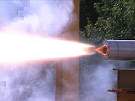
eAc
aerospike hybrid motor test - larger
image
Aerospike
hybrid... "eAc
announces their involvement in a government funded program to develop
an aerospike nozzle for hybrid rocket motor application. (Specifics
of the program cannot be released at this time.)" The photograph
above "shows one of the early firings. This test was cut short
due to structural failure of the plug. Future design has addressed
the structural issues and full duration firings are expected by
month's end."
September
18, 2003
Hybrids
on the rise?... With the continuing regulatory
hassles over solid fuels, particularly ammonium perchlorate
composite propellant (APCP), perhaps more participants in high power
rocketry will move to hybrid rockets. The informative site - FlyHybrids.org
- provides lots on info about this safe but high performance propulsion
alternative.
More
about the MARS high altitude attempt... Richard Osborne
of the MARS Advanced
Rocketry Society sent me some interesting info about their upcoming
launch, including how members stay in touch between Nevada and England
via their own satellite link:
In case you're
wondering how I can email them, one of our sponsors lent us a
VSAT satellite terminal, so hopefully, they'll be able to get
images from the onboard cameras straight back after launch. There
are 2 high resolution CCD colour video cameras onboard, 1 looking
sideways, and 1 looking along the length of the rocket. The video
telemetry is transmitted down at S-band, and we've done it several
times before, so the only glitch I can see there is connections
working loose under the vibration of the motor (it's happenned
a couple of times, so we're at least aware of it).
There are
a bunch of altimeter/accelerometers (several R-DAS units and G-Wiz
units for redundancy). An onboard GPS with an avionics system
for it which we built this year. A bunch of UHF tracking beacons,
and a stills camera. I've spoken to the team on Wednesday evening
GMT, and whilst they're full of the usual optimism that they'll
launch on Friday, I suspect by the time everything is ready, and
all the umbilicals are hooked up to the rocket, it may be Saturday
that the launch will take place.
September
17, 2003
MARS
launch... A busy week for advanced rocketry. I just got
the following announcement from the UK MARS group about a high altitude
rocket attempt this Friday in Nevada:
On September
19th, a team of young British rocketry enthusiasts are preparing
to put a year's hard work to the test, in the Black Rock Desert,
Nevada, U.S.A. The aim? To better the 25,400ft of the last September's
record-breaking flight and hopefully set a new European amateur
altitude record, a new altitude record for a UK built amateur
rocket, and a new altitude record for a UK built hybrid rocket
(amateur or professional). The team are members of the MARS
Advanced Rocketry Society (MARS); the rocket is Deimos Odyssey,
containing the largest amateur hybrid rocket designed, built and
flown in the UK.
2002 saw the twenty-three-foot rocket leap off the pad in a cloud
of dust, and thunder out of sight, reaching Mach 1 in 10 seconds
and gaining a top speed of almost 1,000mph.
The engine behind this impressive performance, developed by the
team, combines Nitrous Oxide and plastic to generate a over a
quarter of a ton of thrust. The static tests carried out over
this last year have been focused on three key areas in order to
enhance the rocket's performance; these are a new injection system,
a re-design of the nozzle and a revolutionary fill system. MARS
are confident that through all of the hard work undertaken during
static testing of the hybrid rocket motor, this year's launch
will not only beat last years record altitude (a record for the
highest altitude reached by a UK built amateur or professional
hybrid rocket), but will also set a new European record, currently
held by MARS at 34,500ft.
Deimos Odyssey is a step on the way towards putting Britain back
in space. This winter work begins in earnest on the next generation
rocket motor, to power the new vehicle Deimos 3, which calculations
have shown can comfortably reach the 100km milestone--the edge
of space.
Additionally, at the same launch campaign, MARS are planning on
launching the GYROC - a MARS developed, gyro stabilised, gimbal
controlled rocket with no fins, and no nosecone, steered entirely
by motor thrust. This innovative rocket, the only gyro stabilised,
gimballed amateur rocket in the UK, has been test launched several
times previously, but will face its toughest test in the Black
Rock Desert.
MARS is supported by a number of generous sponsors, including
Pentax,
Swagelok North London, Linde Gas, Baco Metal Centres, Schlumberger
and JVC Professional, without whom Britain's amateur space programme
would not have been possible.
You can follow the launch campaign and find out more about the
organisation at www.mars.org.uk
and press should contact info@mars.org.uk
for access to the media area.
September
16, 2003
Multi-launch
weekend... Flometrics
and students from San Diego State, UC at San Diego, and City College
will launch a rocket at the RRS
Mojave site this weekend in addition to the Garvey/CSULB aerospike
launch mentioned below. See the Flometrics
Rocket and the SDSU
Rocket Project pages for details.
Early
aerospike motor... Bill Claybaugh of the Reaction
Research Society says that "an RRS member flew a solid
propellant aerospike rocket using Micrograin (S/Zn) propellant in
the early 1960's according to a conversation I had with an RRS member
of that era; I believe the vehicle was 3" diameter. The flight _might_
be documented in an issue of the RRS News from that time period."
I'll note that
a rocketry
group in Utah also launched a small solid propellant
aerospike earlier this year. The Garvey/CSULB effort, though, would
be the first liquid fueled aerospike engine to launch, as far as
I can tell.
Boston
University aerospike project... I received an email from
Luke Colby, a grad student at Georgia Tech, with information about
an aerospike motor project he worked on as an undergrad at Boston
University. He sent me the above images and said the
"...note
on the Aerospike test from the guys out in CA really caught my
attention because I have worked with a team of students at Boston
University on a similar Aerospike nozzle test program. I'm the
founder and former president of the BU
Rocket Team and over the past 2 years we have been working
on experimental rocket motors and a flight vehicle...
...the last
project we worked on before I [left] and a few of the key team
members graduated in May was an Aerospike nozzle configuration.
We developed it completely independently without knowledge of
the Cal State at Long Beach team's very cool project and I am
surprised to see just how similar our approaches to the nozzle
design where. Of course in our case we were using solid propellant
and as a result cast a rod and tube propellant geometry with propellant
covering the central rod supporting the plug, instead of having
a solid graphite rod as their engine does, but conceptually they
are pretty similar.
Unfortunately
the day we were going to launch our rocket the weather was so
bad we had to just do a static test of the engine instead of a
flight test, but the engine did work and if we had just had a
little more time to work out the bugs we would have been the first
student group to flight test an Aerospike nozzle. But Oh well...
that's the way it goes I guess.
At any rate
I thought your readers might be interested in seeing our version
of an aerospike nozzle so I have attached a few photos of our
motor so you can see our design. Additionally there are a couple
frame captures from a subscale test fire of the nozzle and also
the full scale test fire. The BU Rocket Team is planning on trying
again this year to launch the rocket with the aerospike motor
so if they do, I will let you know how it goes. Unfortunately
I'm down at Georgia Tech now for grad school and so can't help
them finish it but I remain very interested in all goings on with
aerospike nozzle technology, which is why I am so pleased to see
another team doing some work with them.
September
15, 2003
Upcoming
aerospike launch... John Garvey says that "plans
are still on for the Prospector
2 flight test of the ablative aerospike engine this coming Saturday/Sunday
(20-21 September) out at the Mojave
Test Area. We only received a solid confirmation about the availability
of the launch site (and more specifically a launch rail) this past
weekend, so we are only now really gearing up for it."
More info about
the aerospike project at Garvey
Spacecraft and Cal
State at Long Beach. See, for example, this
page with pictures of the engine and the vehicle.
This will be
the first launch of a liquid fueled aerospike engine.
September
12, 2003
Engine
tests & aerospike launch upcoming...
The
Department of Aerospace Engineering Rocket Project at Cal State
San Diego will carry out a static
engine test in collaboration with Flometrics
at the Reaction Research Society's desert site during Sept.20-21.
A firing
in May tested the company's innovative pistonless fuel
pump.
In addition,
the Garvey Space/Cal State Long Beach aerospike
rocket launch is planned for that same weekend.
September
10, 2003
Student
payloads on sounding rockets...
The NASA Student
Launch program at Goddard Spaceflight Center will fire an Orion
from Wallops Island on Sept.16th. carrying several student experiments:
UVA
Undergrads Ready for Launch - NASA Goddard - Sept.9.03. The
launch will be webcast.
Alabama
rockoon launchers ... In an interview
on the SpaceShow
Greg Allison of the Huntsville
Alabama L5 Society (HAL5) discussed on July 29th the group's
amateur advanced rocketry projects, which involve balloons carrying
the rockets to high altitudes before they launch.
August
18, 2003
More
Loki's for student launches... A
collaboration of Florida
Space Authority, the Florida
Space Institute and Brevard County Community College has purchased
200 Super-Loki surplus rockets for use in educational programs:
Student
Experimenters Have New Launch Options - Space News - Aug.18.03.
Robert Kleinberger's
Lunar Rocket company is also developing new upper stages for the
Loki that will provide for larger payloads.
August
14, 2003
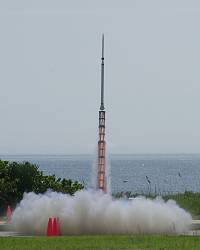
Elementary
school payload rockets to 70 miles...
An educational
program that involves student built payloads for Super-Loki
sounding rockets recently had a successful launch in Florida:
At 10:00 am
on 8 August 2003 a small payload from Rossmoor Elementary School
in Los Alamitos, California launched a small payload to space,
70-mile altitude, from Cape Canaveral Air Force Station Launch
Complex LC-47. The launch, a cooperative effort between the Florida
Space Authority (FSA), the Florida
Space Institute (FSI), and the Lunar Rocket & Rover Co.,
Inc of Los Alamitos, CA, The launch is a milestone in rocketry
in that this is the first elementary school to launch to space
from Cape Canaveral.
More about this
event and the program:
August
13, 2003
Aerospike
launch update... Garvey
Spacecraft reports that the RRS
has submitted a flight waiver request to the FAA for the weekend
of 20-21 September 2003.
New
advanced rocketry group... I recently came
across the site for Project
Colimbo - Amateur Space Lift Team, which has ambitious plans
for "development of a low cost, low earth orbit payload delivery
system."
August
7, 2003
Aerospike
launch upcoming... Garvey
Space/Cal State Long Beach aerospike powered rocket launch scheduled
for August 20-21: Students
Prepare for the First Flight Powered by an Aerospike Engine Using
Liquid Propellants - CSULB - Aug.6.04
August
3, 2003
TWiking
rockets on line... Michael Mealling of Rocketforge has
setup a "TWiki"
page for advanced rocketry discussions called ArocketWiki.
These facilities allow for more extensive interactions that normal
forums. Documents, graphics, etc. can be shared and maintained within
the space. Sort of like a collaborative web site. See Michael's
posting
for more info.
August
1, 2003
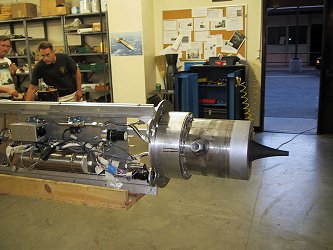
Aerospike engine
installed on the Prospector 2 rocket.
Aerospike
Rocket in preparation... John Garvey sent me a couple
of pictures of the Garvey
Space/Cal
State Long Beach aerospike engine recently installed on the
Prospector 2 rocket.
He says that
"vehicle integration is proceeding in time to support a launch
attempt in the next month or so. Much of the attention is focused
on developing a pneumatic-based recovery system. The pacing schedule
item at this point is availability of the launch site."
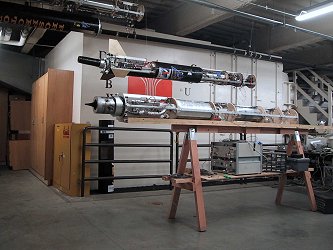
Prospector 2
on table with aerospike engine installed.
(Prospector 1 and 3, recovered from previous flights, hang
above and to the top left of the P-2)
With regard
to the above picture he says "you might notice some of the
other vehicles in the [...] photo (Prospector
1 and 3). All three of these have flown and been successfully
recovered. We plan to re-fly the P-3 again after the P-2 aerospike
experiment to continue development of various flight control technologies."
Continue
to July 2003
|


